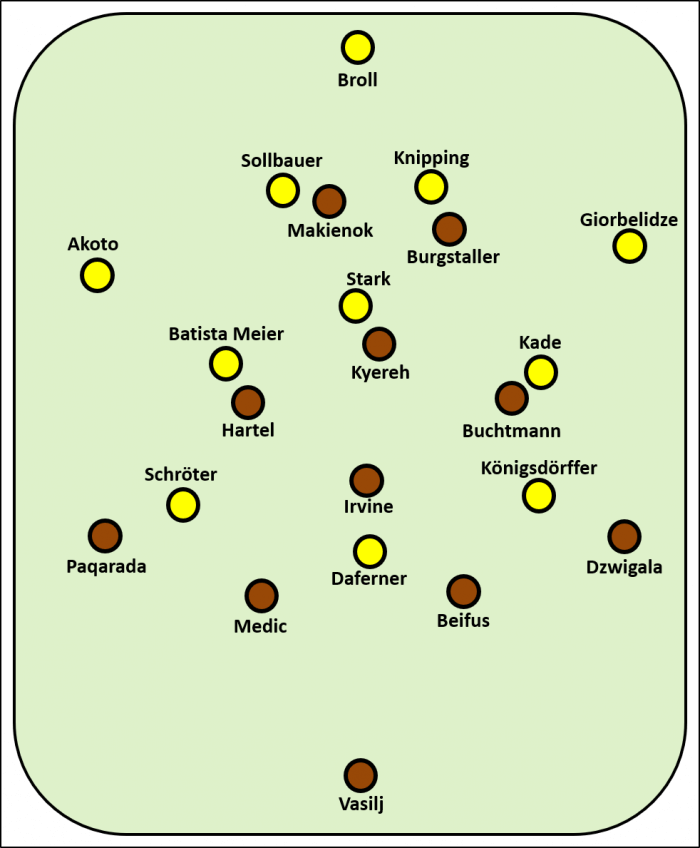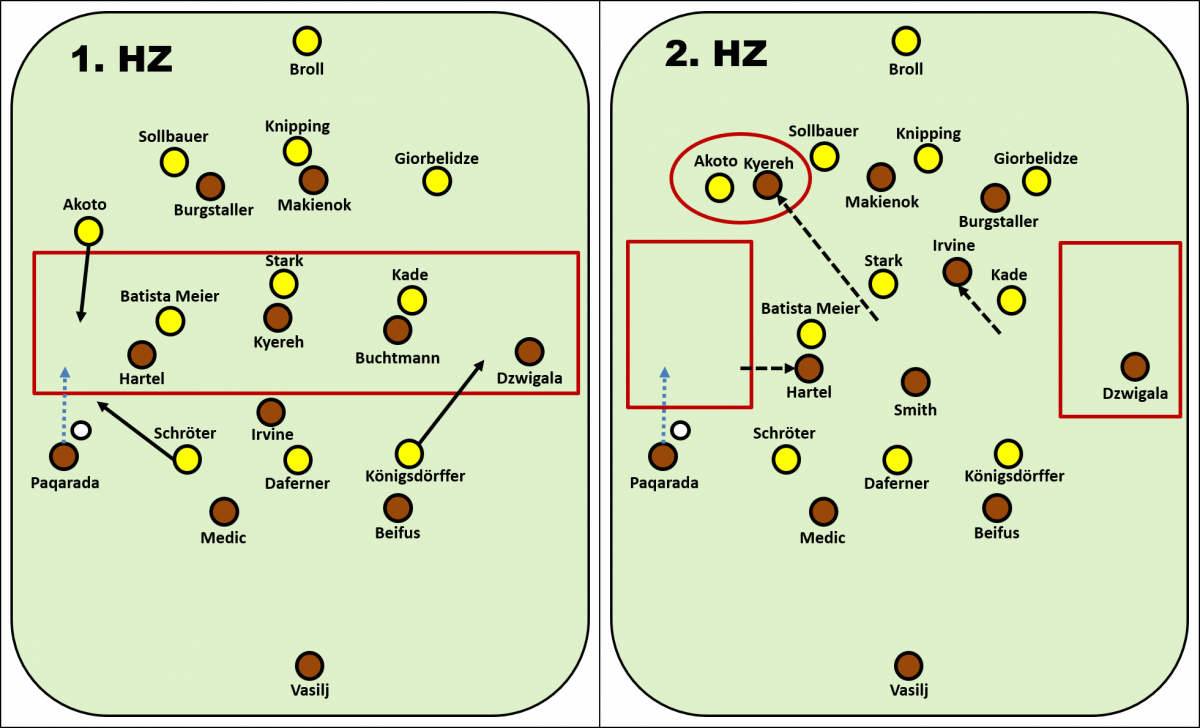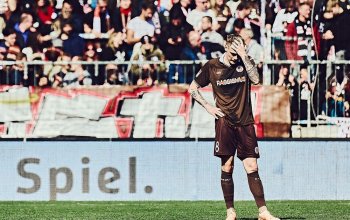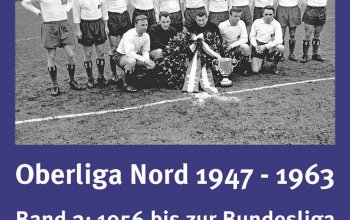Der FC St. Pauli holt einen Punkt beim Auswärtsspiel in Dresden. Nach einer ersten Halbzeit, in der vor allem das Passspiel unpräzise war, steigerte sich das Team im zweiten Durchgang enorm. Ursächlich dafür war ein personeller Wechsel und eine verbesserte Positionierung. Unpräzise waren dann aber meist die Torabschlüsse, sodass sich das Team mit einem Punkt begnügen muss.
(Titelbild: Bert Harzer/Eibner-Pressefoto/via Imago Images/via OneFootball)
Die Aufstellung
Eine personelle Veränderung gab es beim FC St. Pauli im Vergleich zum Heimsieg gegen den Karlsruher SC: Adam Dźwigała ersetzte Luca Zander auf der rechten Abwehrseite. Er machte seine Sache sehr ordentlich.
Bei Dynamo Dresden gab es zwei Veränderungen: Stammtorwart Kevin Broll kehrte nach seinem Handbruch ins Tor zurück, im Feld galt gleiches für Yannick Stark nach Gelbsperre (er ersetzte den zuletzt starken, aber nun verletzten Sebastian Mai).

Pässe aus der Vorhölle
Es folgte eine erste Halbzeit, die aus Sicht des FC St. Pauli als schwierig bezeichnet werden muss. Dynamo Dresden presste mit seinem 4-3-3 meist recht hoch, ließ aber bereits in den ersten 45 Minuten den Druck auf die gegnerischen Außenverteidiger vermissen. Das ist gegen den FCSP bekanntlich eine nicht so gute Idee. Aber ganz anders als zuletzt gegen den KSC konnte der FCSP diesen Vorteil im Spielaufbau nicht wirklich für sich nutzen. Denn irgendwann wurde der Druck auf die Außenverteidiger doch hoch und Paqarada und Dźwigała boten sich sehr wenige Anschlusshandlungen, da wenig vertikale Passoptionen zur Verfügung standen. Offensiven Druck konnte der FCSP trotz hoher Ballbesitzquote nicht entfalten.
Das Gegenteil war sogar der Fall: Nach und nach wurde Dresden enorm gefährlich über die Außenbahn, weil der FCSP wieder mal Probleme mit der Rückverteidigung bekam. Ich würde das aber nicht als ein Problem der unzureichenden Staffelung des Teams bezeichnen. Vielmehr war das eigene Passspiel schwach. Es war relativ simpel für den FCSP die vorderste Dreierreihe zu überspielen. Im zweiten Drittel hatte der FCSP dann meist eine Überzahl, mit den beiden Außenverteidigern sowie Buchtmann, Hartel und Kyereh (der sich gerne in diese Linie fallen ließ). Das Dreier-Mittelfeld von Dresden ist damit eigentlich überfordert gewesen. Denn das Team von Trainer Capretti schaltete meist nur sehr langsam aus dem 4-3-3 in sein 4-5-1 um, welches sie im tiefen Pressing spielten. Druck auf die Außenverteidiger des FCSP erzeugten sie dann weniger durch die offensiven Außenspieler, sondern über die eigenen Außenverteidiger.
Das Problem des FC St. Pauli war also nicht, dass sie im Aufbau keine Vorteile gehabt hätten. Aber dadurch, dass gleich fünf FCSP-Spieler auf einer Linie standen, fehlte es ein wenig an Tiefe im Spiel. Viel schlimmer aber: Das eigene Passspiel war unzureichend. Es wurden einfach brutale Fehlpässe gespielt. Marcel Hartel, eigentlich ein Meister im Passspiel, ist da ein gutes Beispiel. Bevor aber Hartel die schleppenden ersten 45 Minuten angelastet werden: Christopher Buchtmann war da nur nicht auffällig, weil er insgesamt nur neun Pässe spielte. Hartel spielte über 50, also fünfmal so viele (bei mehr Spielzeit). Paqarada spielte auch fünfmal so viele, aber pro Halbzeit. Schon beim Spiel gegen Karlsruhe war Buchtmann weniger durch Ballaktionen, sondern vor allen durch Härte aufgefallen (auch da spielte er die wenigsten Pässe aller FCSP-Spieler auf dem Platz (Vasilj eingeschlossen)).

(Bert Harzer/Eibner-Pressefoto/via Imago Images/via OneFootball)
Die vielen Fehlpässe und nicht optimalen Positionierungen führten dann häufig zu gefährlichen Situationen für Dresden. Bei Ballgewinn orientierte sich Mittelstürmer Daferner auf die Außenbahn und die beiden offensiven Außen rückten gerne ins Zentrum nach. Der Raum auf der Außenbahn war vorhanden, da beide Außenverteidiger des FCSP weiter vorgerückt waren. Dieses Vorrücken war aber nicht das Problem an sich, sondern es waren die vielen Ballverluste durch das schwache Passspiel, die dazu führten. In vielen Momenten konnte der FCSP es sogar noch ganz gut verteidigen, aber bei der hohen Anzahl an Ballverlusten war halt auch nicht alles zu verhindern.
Dynamo Dresden hatte viele Chancen in der ersten Halbzeit, einige davon sehr schön rausgespielt. Was aber definitiv zu verhindern war, und was mich fürchterlich fluchen ließ, war das Gegentor. Denn Leart Paqarada und Guido Burgstaller schauten entspannt zu, wie der Standard über ihre Köpfe hinwegflog. Sie bleiben dann einfach stehen. Das der Ball vom zweiten Pfosten zurück ins Zentrum gespielt werden könnte, schien ihnen entfallen zu sein. Daferner blieb nicht stehen, sondern lief ein und stand aufgrund der Zuschauer auf Seiten des FCSP völlig blank. Man ey, das war richtig schlecht verteidigt.
Zu selten den Exit gewählt
Was hätte das Team tun können, um sich selbst aus diesem Schlamassel zu ziehen? Grundsätzlich bot das Aufbauspiel einige Optionen, wenngleich es in der zweiten Halbzeit noch taktisch etwas besser gelöst wurde. Was aber gar nicht genutzt wurde, wenn der Raum mal knapp war: Der lange Ball auf Simon Makienok. Ich mein, der Typ steht auch deswegen auf dem Platz, weil der FC St. Pauli mit ihm noch diese Option mehr im Aufbau hat. Das stellt den Gegner vor massive Probleme. Aber wenn es dann nicht oder nur unzureichend genutzt wird, dann kann ein Gegner woanders auf dem Platz mutiger verteidigen.
Wenn die langen Bälle dann mal kamen, dann war aber auch die eigene Positionierung ein Problem, da Kyereh meist irgendwo tief im Mittelfeld herumtanzte und um Makienok herum einfach zu viel Gelb-Schwarz zu sehen war. Timo Schultz hatte schon nach dem KSC-Spiel betont, dass er sich von seinem Team wünscht, dass sie diese Exit-Strategie noch häufiger spielen. Gegen Dresden dürfte er deshalb fast wahnsinnig geworden sein.
Dabei ist es so wichtig, dass man diese Option zumindest ab und an mal vernünftig ausspielt. Das ist dann wie beim American Football, wo man sich ja immer zwischen Pass und Run Game entscheiden muss. Spielt man nur eines, kann sich die gegnerische Defense darauf einstellen und da etwas mutiger werden. Wechselt ein Team immer fleißig zwischen Pass- und Laufspiel, muss der Gegner immer auf alle Eventualitäten vorbereitet sein und kann sich nicht auf eine Art der Defensivarbeit konzentrieren. Wohl dosierte lange Bälle auf Makienok hätten sehr geholfen, um die Defensivarbeit von Dresden vorsichtiger werden zu lassen. Stattdessen drückten sie in der ersten Halbzeit immer mutiger.
Das klingt alles sehr negativ und das ist in gewisser Weise auch so gemeint. Aber es wurde in der ersten Halbzeit deutlich, dass der FCSP die bessere Spielanlage hat, trotz der hohen Fehlpass-Anzahl. Das Team kam dann kurz vor der Pause per Standard (und Torwartfehler) zum Ausgleich. Zu diesem Zeitpunkt war das ziemlich glücklich.
In der ersten Halbzeit gewann der FC St. Pauli nur 43% seiner Zweikämpfe. In der zweiten Halbzeit waren es 53%. Zudem spielte das Team vor dem Seitenwechsel 34 progressive Pässe (= Pässe, die dem gegnerischen Tor signifikant näher kommen) mit einer Erfolgsquote von 78%. In den zweiten 45 Minuten waren es 58 davon (89% erfolgreich). Die xG-Werte aus Halbzeit eins (0.74 – 2.04 aus Sicht des FCSP) wurden deutlich gedreht (2.4 – 0.29). Der FC St. Pauli wurde in der zweiten Halbzeit sehr dominant und hatte sich da den Siegtreffer durchaus noch verdient. Aber was genau hat sich im Spiel eigentlich geändert?
Leart und Adam mit noch mehr Raum und Zeit
Zwar hatten Leart Paqarada und Adam Dźwigała bereits in der ersten Halbzeit eher viel Raum, aber irgendwann zog sich die Pressing-Schlinge von Dresden zu und die Passwege schlossen sich. Aber die unfassbaren knapp 70 Ballaktionen von Paqarada in den zweiten 45 Minuten zeigten, dass sich da was verändert hatte.
Das Aufbauspiel des FC St. Pauli griff nun besser, weil es dem Team nun gelang mehr Raum für die Außenverteidiger und mehr vertikale Passoptionen anzubieten. Schaut mal auf die Grafik:

In der ersten Halbzeit hatte der FC St. Pauli im Mittelfeld eigentlich eine Überzahl, sobald Paqarada und Dźwigała auf Höhe der Mittelfeld-Kollegen rückten. Aber genau das war auch eines der Probleme: Dadurch das alle Spieler auf einer Linie waren, boten sich eher wenig vertikale Passoptionen. Und da Kyereh sich meist mit ins zentrale Mittelfeld fallen ließ, war auch der lange Ball auf Makienok keine Option, da die Positionierung für diese Spielweise nicht passend war.
Zudem wurde das Spiel auf der Mittelfeldlinie zu eng, da auch Marcel Hartel gerne auf der linken Seite herumturnte (zentral waren ja Kyereh und Buchtmann). So war der Raum dann insgesamt doch etwas knapp für Paqarada. Der wurde dann auch noch knapper, wenn ihn Schröter aus der offensiven Dreierreihe und Akoto aus der defensiven Viererkette anliefen.
Zwei Änderungen in der Positionierung und eine Änderung im Dresdener Spiel führten dann in der zweiten Halbzeit zum kompletten Kippen des Spiels (ich mache das hier mal am Beispiel linke Außenbahn):
- Daniel-Kofi Kyereh positionierte sich bei Ballbesitz nun viel häufiger auf der linken offensiven Seite. Dadurch wurde Dresdens Außenverteidiger Akoto links hinten gebunden. Er konnte Paqarada nicht mehr anlaufen = Zeit- und Raumgewinn für Leart Paqarada.
- Marcel Hartel hielt sich nun viel mehr im Halbraum auf und ließ sich weniger auf die linke Seite fallen. Auch dadurch: Zeit- und Raumgewinn für Leart Paqarada.
- Dynamo Dresden spielte sehr intensive erste 45 Minuten und betrieb vor allem in vorderster Reihe einen enormen läuferischen Aufwand. Je länger das Spiel dauerte, umso langsamer gelang das Umschalten vom 4-3-3 in 4-5-1, mit dem man die Außenverteidiger besser unter Druck hätte setzen können. Morris Schröter schaffte die Laufwege schlicht nicht mehr = Zeit- und Raumgewinn für Leart Paqarada.
Fehlende Präzision setzt sich an anderer Stelle fort
Das war schon eine ziemlich gute Reaktion des FC St. Pauli auf das Pressing von Dynamo Dresden. In den ersten 20 Minuten der zweiten Halbzeit konnte Dynamo überhaupt keinen Zugriff mehr auf das FCSP-Spiel generieren. In dieser Phase hatte der FCSP die Führung mehrfach auf dem Fuß, obwohl das Passspiel weiterhin fehleranfällig war (aber besser als noch in den ersten 45 Minuten). Die Präzision fehlte aber nicht nur im Passspiel, sondern auch im Torabschluss. Viermal traf das Team Latte oder Pfosten in der 2. Halbzeit, Irvine und Burgstaller hatten weitere Großchancen.
SGD-Trainer Guerino Capretti reagierte eher spät auf den fehlenden Zugriff in der zweiten Halbzeit. 20 Minuten lang schaute er dem Treiben auf dem Platz nur zu. Dabei war schon kurz nach Wiederanpfiff klar, dass die veränderte Positionierung des FC St. Pauli die Schwachstellen im 4-3-3 von Dresden brutal offengelegt hatte. In der 65. Minute wechselte er dann Mörschel für Batista Meier ein und stellte seine Formation auf ein 5-3-2 um, mit Schröter als rechten Flügelverteidiger. Bei dieser Formation war die Zuordnung und auch der Zugriff auf die gegnerischen Außenverteidiger wieder viel klarer. In der Folge konnte dem enorm druckvollen Angriffsspiel des FC St. Pauli wieder etwas der Wind aus den Segeln genommen werden.

(Bert Harzer/Eibner-Pressefoto/via Imago Images/via OneFootball)
Doch weiterhin hatte der FCSP die bessere Spielanlage und hätte noch sehr viel mehr erreichen können. Ein Grund dafür war sicher auch, dass zwei Spieler wieder auf ihren besten Positionen gute Leistungen zeigten: Eric Smith kehrte auf die Sechs zurück und seine Passsicherheit im Sechserraum, sowie sein Stellungsspiel in Umschaltmomenten sind dann einfach richtig groß. Wenn er das bloß immer so zeigen könnte. Auch Jackson Irvine zeigte, dass er auf der Halbposition dann doch noch ein bisschen besser aufgehoben ist, da er von dort immer wieder gefährlich in den gegnerischen Strafraum vorstoßen kann.
Aber auch in der zweiten Halbzeit blieb die Präzision im Passspiel im letzten Drittel verhältnismäßig schwach. Die Präzision in den Torabschlüssen wurde auch nicht besser. Letztlich fühlt es sich wie zwei verlorene Punkte an.
So müssen wir dann alle mit diesem Punkt leben. Basierend auf einer schwachen ersten Halbzeit ist das sicher etwas glücklich. Basierend auf der zweiten Halbzeit, in der der FC St. Pauli klar überlegen war, hätte da durchaus mehr als das Unentschieden bei rausspringen dürfen.
Immerhin erging es Darmstadt am Freitag nicht besser (nur Unentschieden gegen Sandhausen) und Werder verlor sogar sein Spiel (1:2 gegen Heidenheim, die sich sogar noch vor dem Spiel gegen den FCSP dezimierten (Rot für Busch)). Es bleibt dabei, dass sich im Aufstiegskampf kein Team absetzen kann und alles läuft schon jetzt darauf hinaus, dass sich ein echtes Herzschlagfinale entwickelt. Und da ist der FC St. Pauli weiterhin mittendrin. Geil!
Immer weiter vor!
//Tim
Alle Beiträge beim MillernTon sind gratis. Wir freuen uns aber sehr, wenn Du uns unterstützt.
MillernTon auf BlueSky // Mastodon // Facebook // Instagram // Threads // WhatsApp // YouTube
{:}{:en}FC St. Pauli earns a point in the away match in Dresden. After a first half in which the passing game was particularly imprecise, the team improved enormously in the second half. This was due to a change in personnel and improved positioning. However, the goals were mostly inaccurate, so the team had to settle for a point.
(Cover picture: Bert Harzer/Eibner-Pressefoto/via Imago Images/via OneFootball)
The line-up
FC St. Pauli made one change compared to the home win against Karlsruher SC: Adam Dźwigała replaced Luca Zander on the right side of the defence. He did a very good job.
Dynamo Dresden made two changes: Regular goalkeeper Kevin Broll returned to goal after breaking his hand, and Yannick Stark did the same on the field after a yellow ban (he replaced Sebastian Mai, who had been strong recently but was now injured).

Passes from limbo
A first half followed which, from FC St. Pauli’s point of view, had to be described as difficult. Dynamo Dresden pressed mostly quite high with their 4-3-3 but lacked pressure on the opposing full-backs already in the first 45 minutes. As we all know, that is not such a good idea against FCSP. But quite different from the last time against KSC, FCSP could not really use this advantage in the build-up of the game for themselves. After all, at some point the pressure on the full-backs became high and Paqarada and Dźwigała were offered very few link-up actions, as few vertical passing options were available. FCSP was unable to exert any offensive pressure despite a high possession rate.
In fact, the opposite was the case: little by little, Dresden became enormously dangerous on the flanks because FCSP once again had problems with their defence at the back. However, I would not describe this as a problem of the team’s inadequate positioning. Rather, the own passing game was weak. It was relatively easy for FCSP to play through the front three. In the second period, FCSP mostly had a superior number, with the two full-backs as well as Buchtmann, Hartel and Kyereh (who liked to drop into this line). Dresden’s three-man midfield was actually overwhelmed by this. Coach Capretti’s team was mostly very slow to switch from the 4-3-3 to their 4-5-1, which they played in deep pressing. They then created pressure on the FCSP wing-backs not so much through the offensive wingers, but through their wing-backs.
FC St. Pauli’s problem was not that they had no advantages in the build-up. But the fact that five FCSP players were on the same line meant that there was a lack of depth in the game. But much worse: their own passing game was insufficient. There were simply brutal bad passes. Marcel Hartel, actually a master in the passing game, is a good example. But before Hartel is blamed for the sluggish first 45 minutes: Christopher Buchtmann was only not conspicuous because he only played a total of nine passes. Hartel played over 50, five times as many (with more playing time). Paqarada also played five times as many, but per half. Already in the game against Karlsruhe, Buchtmann was conspicuous less for his ball actions than for his toughness (he also played the fewest passes of all FCSP players on the pitch (including Vasilj)).

(Bert Harzer/Eibner-Pressefoto/via Imago Images/via OneFootball)
The many misplaced passes and sub-optimal positioning often led to dangerous situations for Dresden. When the ball was won, centre-forward Daferner moved to the flank and the two attacking wingers were happy to move into the centre. The space on the flank was there because both FCSP wing-backs had moved forward. However, this advancing was not the problem per se, but it was the many ball losses due to the weak passing game that led to it. In many moments, FCSP was even able to defend quite well, but with the high number of ball losses, not everything could be prevented.
Dynamo Dresden had many chances in the first half, some of them beautifully played out. But what was definitely preventable, and what made me swear terribly, was the goal against. Because Leart Paqarada and Guido Burgstaller watched relaxed as the standard flew over their heads. They then simply stopped. The fact that the ball could be played back into the centre from the second post seemed to have slipped their minds. Daferner didn’t stop, but ran in and stood completely blank because of the spectators on the FCSP side. Come on lads, that was really bad defending.
Exit too rarely chosen
What could the team have done to pull themselves out of this mess? Basically, the build-up play offered some options, although it was solved a little better tactically in the second half. But what was not used at all when space was tight: the long ball to Simon Makienok. I mean, the guy is also on the pitch because FC St. Pauli has this extra option in the build-up with him. That poses massive problems for the opponent. But if it’s not used or only insufficiently used, then an opponent can defend more courageously elsewhere on the pitch.
When the long balls did come, however, their positioning was also a problem, as Kyereh was usually dancing around somewhere deep in midfield and there was simply too much yellow and black around Makienok. Timo Schultz had already stressed after the KSC game that he would like his team to play this exit strategy even more often. Against Dresden, he must have therefore almost gone mad.
It is so important to use this option properly at least once in a while. It’s like in American football, where you always have to decide between the pass and the run game. If you only play one, the opposing defence can adjust to it and become a little more courageous. If a team always switches diligently between the passing and running game, the opponent must always be prepared for all eventualities and cannot concentrate on one type of defensive work. Well-dosed long balls to Makienok would have helped a lot to make Dresden’s defensive work more cautious. Instead, they pressed more and more courageously in the first half.
That all sounds very negative, and in a way, it is meant to be. But it was clear in the first half that FCSP had the better game, despite the high number of bad passes. The team then equalised shortly before the break via a standard (and goalkeeper error). At that point, it was quite fortunate.
In the first half, FC St. Pauli won only 43% of its duels. In the second half, it was 53%. In addition, the team played 34 progressive passes (= passes that come significantly closer to the opponent’s goal) with a success rate of 78% before the change of ends. In the second 45 minutes, there were 58 of them (89% successful). The xG values from half-time one (0.74 – 2.04 from FCSP’s point of view) were clearly turned around (2.4 – 0.29). FC St. Pauli became very dominant in the second half and deserved the winning goal. But what exactly changed in the game?
Leart and Adam with even more space and time
Although Leart Paqarada and Adam Dźwigała already had rather a lot of space in the first half, Dresden’s pressing noose tightened at some point and the passing lanes closed. But Paqarada’s incredible 70 ball actions in the second 45 minutes showed that something had changed.
FC St. Pauli’s build-up play was now grasping better as the team now managed to offer more space for the full-backs and more vertical passing options. Have a look at the graphic:

In the first half, FC St. Pauli actually had an upper hand in midfield as soon as Paqarada and Dźwigała moved level with their midfield colleagues. But that was also one of the problems: With all players on one line, there were few vertical passing options. And since Kyereh mostly dropped into central midfield, the long ball to Makienok was not an option either, as the positioning was not suitable for this style of play.
In addition, the play on the midfield line became too tight, as Marcel Hartel also liked to run around on the left (Kyereh and Buchtmann were central). So the space was a bit tight for Paqarada. The space became even more limited when Schröter from the offensive three-man line and Akoto from the defensive four-man line ran into him.
Two changes in positioning and one change in Dresden’s play then led to a complete overturn of the game in the second half (I’ll use the example of the left-wing here):
- Daniel-Kofi Kyereh now positioned himself much more often on the left offensive side when in possession. This tied up Dresden’s full-back Akoto at left-back. He could no longer run into Paqarada = time and space gained for Leart Paqarada.
- Marcel Hartel was now much more in the half-space and dropped less to the left side. This also helped: Gain of time and space for Leart Paqarada.
- Dynamo Dresden played a very intense first 45 minutes and made an enormous running effort, especially in the front line. The longer the game lasted, the slower the switch from 4-3-3 to 4-5-1, which could have put the full-backs under better pressure. Morris Schröter simply couldn’t make the runs anymore = gaining time and space for Leart Paqarada.
Lack of precision continues elsewhere
That was a pretty good reaction of FC St. Pauli to the pressing of Dynamo Dresden. In the first 20 minutes of the second half, Dynamo could no longer generate any grip at all on the FCSP game. During this phase, FCSP had the lead on their feet several times, although the passing game was still error-prone (but better than in the first 45 minutes). However, precision was not only lacking in the passing game, but also in goal scoring. The team hit the crossbar or post four times in the 2nd half, Irvine and Burgstaller had other great chances.
SGD coach Guerino Capretti reacted rather late to the lack of access in the second half. For 20 minutes, he just watched the action on the pitch. It was clear shortly after the restart that the change in FC St. Pauli’s positioning had brutally exposed the weaknesses in Dresden’s 4-3-3. In the 65th minute, he then substituted Mörschel for Batista Meier and changed his formation to a 5-3-2, with Schröter as a right wing-back. With this formation, the allocation and also the access to the opposing full-backs was much clearer again. As a result, the wind was taken out of the sails of FC St. Pauli’s enormously pressured attacking play.

(Bert Harzer/Eibner-Pressefoto/via Imago Images/via OneFootball)
But FCSP still had the better game and could have achieved much more. One reason for this was certainly that two players performed well again in their best positions: Eric Smith returned to the six and his passing security in the six-man area, as well as his positional play in switching moments, are simply really great. If only he could show that all the time. Jackson Irvine also showed that he is a bit better at the half position, as he can always make dangerous inroads into the opponent’s penalty area from there.
But also in the second half, the precision in passing remained relatively weak in the final third. The precision in the goal finishes did not improve either. In the end, it feels like two points lost.
So we all have to live with this point. Based on a weak first half, it’s certainly a bit lucky. Based on the second half, in which FC St. Pauli was superior, it could have been more than a draw.
After all, Darmstadt did not fare any better on Friday (only a draw against Sandhausen) and Werder even lost their game (1:2 against Heidenheim, who were even decimated before the game against FCSP (red for Busch)). It remains the case that no team can pull away in the fight for promotion and everything already boils down to a real heartbeat finale developing. And FC St. Pauli is still right in the middle of it. Cool!
Keep moving forward!
//Tim (translation by Arne)
MillernTon Twitter //
MillernTon YouTube //
MillernTon Facebook //MillernTon Instagram //
If you like what we do here, here you’ll find the information on how to support us.
{:}




Mal wieder eine wirklich gelungene Analyse – informativ & gut zu lesen. Vielen Dank und weiter so!
Da denkt man durch die Artikel hier man hat moderne Fußballtaktik und unsere Spielidee einigermaßen verstanden und dann sieht man die erste Halbzeit und steht doch wieder vor klassischen Kreisligaproblemen:
-einfachste Pässe kommen nicht an
-Spieler machen nicht das was der Trainer sagt (langer Ball auf Makienok)
-Spieler hören auf zu verteidigen (Gegentor)
Wobei die Fehlpässe meiner Ansicht nach vielfach eben auch durch eine schlechte Positionierung bedingt waren. Die Räume waren teilweise sehr eng, durch die gespielt werden sollte, und sehr oft waren die Pässe auch mangels alternativer Anspielmöglichkeiten leicht zu antizipieren.
Im Grunde genommen hat Dresden gegen Paqarada zudem statt einer Pressing- eher eine Art Passfalle aufgebaut: Paqarada hat – wie so oft – versucht, den Ball ins Zentrum zu spielen, wenn und weil er keine vertikale Anspielstation hatte und ist damit oft genug gescheitert. Die Pässe waren leicht zu erahnen, wodurch Dresden immer wieder Umschaltmomente generieren konnte, bei denen ein Großteil der Gegenspieler bereits überspielt war.
Hier stimmte Paqaradas Risikoeinschätzung überhaupt nicht – er hätte viel öfter simpel zurück zu Medic spielen müssen. Da Paqarada bekanntermassen gerne solche riskanten Pässe spielt, sah es für mich sehr danach aus, als ob Dresden genau diese Situationen erzeugen wollte, indem drei von Schröter, Batista Meier, Akoto und Stark die Passwege zu Hartel, Irivine und Kyereh zustellten und der vierte auf Paqarada draufging. Dagegen hätte geholfen, wenn wir über Medic – Beifus / Dzwigala – Buchtmann mit Tempo die Seite verlagert hätten: Letztere beiden standen oft genug blank, da der Rest der Dredner sich entsprechend zum Zentrum hin orientieren musste.
Hatte gestern Abend nach dem Werder-Ergebnis ein „einen Punkt gewonnen“-Gefühl, das hat sich heute aber mal schön relativiert…Was solls, wir können D98/Werder/Heidenheim/FCN/S04 allen noch 3 Punkte abnehmen, also dran-drauf-drüber! Aber, Tim, was da los mit Deiner umgekehrten Psychologie betreffs Burgi?
Es ist so einfach: Wir haben es immer noch in der eigenen Hand. Und die 2. Halbzeit macht zumindest etwas mehr Mut.